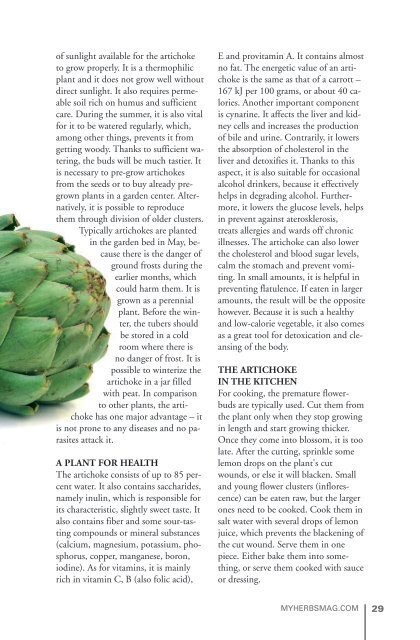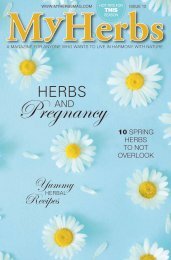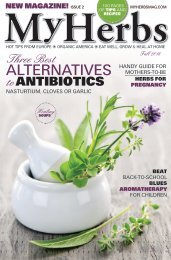My Herbs 1
Find out more on MYHERBS-STORE.COM. My Herbs is a special quarterly publication for anyone who is interested in alternative cooking, home grown herbs, and traditional or complementary medicine or healing methods, simply for everyone who wants to live in harmony with nature.
Find out more on MYHERBS-STORE.COM.
My Herbs is a special quarterly publication for anyone who is interested in alternative cooking, home grown herbs, and traditional or complementary medicine or healing methods, simply for everyone who wants to live in harmony with nature.
Create successful ePaper yourself
Turn your PDF publications into a flip-book with our unique Google optimized e-Paper software.
of sunlight available for the artichoke<br />
to grow properly. It is a thermophilic<br />
plant and it does not grow well without<br />
direct sunlight. It also requires permeable<br />
soil rich on humus and sufficient<br />
care. During the summer, it is also vital<br />
for it to be watered regularly, which,<br />
among other things, prevents it from<br />
getting woody. Thanks to sufficient watering,<br />
the buds will be much tastier. It<br />
is necessary to pre-grow artichokes<br />
from the seeds or to buy already pregrown<br />
plants in a garden center. Alternatively,<br />
it is possible to reproduce<br />
them through division of older clusters.<br />
Typically artichokes are planted<br />
in the garden bed in May, because<br />
there is the danger of<br />
ground frosts during the<br />
earlier months, which<br />
could harm them. It is<br />
grown as a perennial<br />
plant. Before the winter,<br />
the tubers should<br />
be stored in a cold<br />
room where there is<br />
no danger of frost. It is<br />
possible to winterize the<br />
artichoke in a jar filled<br />
with peat. In comparison<br />
to other plants, the artichoke<br />
has one major advantage – it<br />
is not prone to any diseases and no parasites<br />
attack it.<br />
A PLANT FOR HEALTH<br />
The artichoke consists of up to 85 percent<br />
water. It also contains saccharides,<br />
namely inulin, which is responsible for<br />
its characteristic, slightly sweet taste. It<br />
also contains fiber and some sour-tasting<br />
compounds or mineral substances<br />
(calcium, magnesium, potassium, phosphorus,<br />
copper, manganese, boron,<br />
iodine). As for vitamins, it is mainly<br />
rich in vitamin C, B (also folic acid),<br />
E and provitamin A. It contains almost<br />
no fat. The energetic value of an artichoke<br />
is the same as that of a carrott –<br />
167 kJ per 100 grams, or about 40 calories.<br />
Another important component<br />
is cynarine. It affects the liver and kidney<br />
cells and increases the production<br />
of bile and urine. Contrarily, it lowers<br />
the absorption of cholesterol in the<br />
liver and detoxifies it. Thanks to this<br />
aspect, it is also suitable for occasional<br />
alcohol drinkers, because it effectively<br />
helps in degrading alcohol. Furthermore,<br />
it lowers the glucose levels, helps<br />
in prevent against aterosklerosis,<br />
treats allergies and wards off chronic<br />
illnesses. The artichoke can also lower<br />
the cholesterol and blood sugar levels,<br />
calm the stomach and prevent vomiting.<br />
In small amounts, it is helpful in<br />
preventing flatulence. If eaten in larger<br />
amounts, the result will be the opposite<br />
however. Because it is such a healthy<br />
and low-calorie vegetable, it also comes<br />
as a great tool for detoxication and cleansing<br />
of the body.<br />
THE ARTICHOKE<br />
IN THE KITCHEN<br />
For cooking, the premature flowerbuds<br />
are typically used. Cut them from<br />
the plant only when they stop growing<br />
in length and start growing thicker.<br />
Once they come into blossom, it is too<br />
late. After the cutting, sprinkle some<br />
lemon drops on the plant's cut<br />
wounds, or else it will blacken. Small<br />
and young flower clusters (inflorescence)<br />
can be eaten raw, but the larger<br />
ones need to be cooked. Cook them in<br />
salt water with several drops of lemon<br />
juice, which prevents the blackening of<br />
the cut wound. Serve them in one<br />
piece. Either bake them into something,<br />
or serve them cooked with sauce<br />
or dressing.<br />
MYHERBSMAG.COM<br />
29












